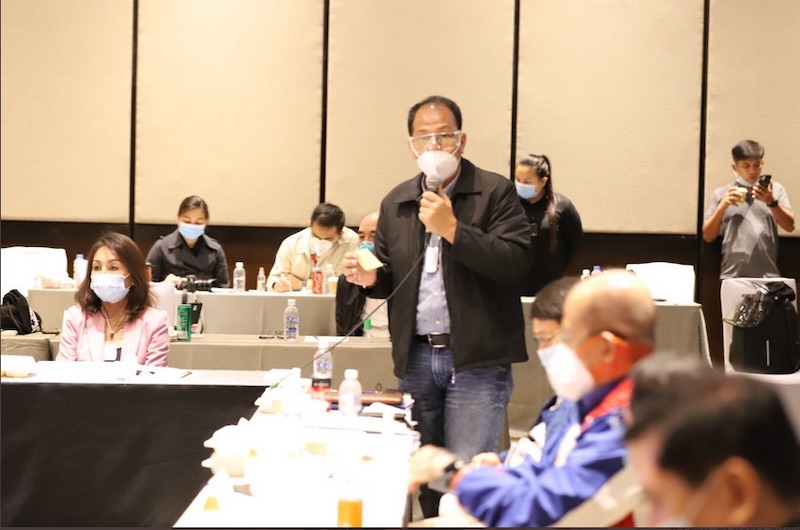DAVAO CITY (MindaNews/ 28 June) – A lockdown supposedly intended to prevent the spread of the highly contagious COVID-19 has reached over a hundred days and is said to be the world’s longest but the cases continue to rise so what’s the next step, what are the other options, MindaNews asked Secretary Carlito Galvez, Presidential Adviser on the Peace Process and concurrent Chief Implementer of the National Task Force against COVID-19.
Did the Inter-Agency Task Force on the Management of Emerging Infectious Diseases assess the hundred-day lockdown in their meeting Monday last week and what other options and solutions did they discuss?
 Secretary Carlito Galvez, Presidential Adviser on the Peace Process and concurrent Chief Implementer of the National Action Plan of the National Task Force Against COVID-19. Photo courtesy of NTF Twitter
Secretary Carlito Galvez, Presidential Adviser on the Peace Process and concurrent Chief Implementer of the National Action Plan of the National Task Force Against COVID-19. Photo courtesy of NTF Twitter
MindaNews sent Galvez these questions twice last week, on June 23 and 25. He answered on Saturday afternoon, June 27, that there was a “thorough assessment.”
“We had an ongoing thorough assessment from the six-month battle with COVID. We will find out the current state of our response and the situation prevailing in different areas nationwide,” he said.
Galvez added that they are “now writing the sequel of the National Action Plan (NAP) as Phase 2 for the period of July to September, bringing the lessons learned of our past experience and models from other countries.”
Galvez is Chief Implementer of NAP.
The next phase, he said, will highlight on “how to sustain our gains, address emerging challenge on the continuous rise of cases, how to save more lives, reboot our economy, address resurgence in Cebu, and mitigate the social impact of the COVID and prepare for other compounding problems on unemployment, other disasters and contingencies.”
MindaNews sent follow-up questions but Galvez responded: “I am sorry, I am in a meeting now.” MindaNews followed up on Sunday but Galvez has yet to answer.
Local government units are awaiting the decision of the Inter-Agency Task Force on the Management of Emerging Infectious Diseases (IATF-EID) on the status of the quarantine measures which are supposed to end on June 30 unless extended again or re-classified.
The country has been under various types of lockdown since March 15: community quarantine (CQ), enhanced community quarantine (ECQ), modified ECQ (MECQ), general community quarantine (GCQ) and modified GCQ (MGCQ) which is supposed to be a step away from the “new normal.”
In Mindanao, out of 27 provinces and 33 cities, only the cities of Davao and Zamboanga remain on extended GCQ until June 30. The rest have been under MGCQ since June 1 but these are the areas where an exponential rise in number of cases has been noted due to the arrival of Locally Stranded Individuals (LSIs) and Returning Overseas Filipins (ROFs) who did not go through a Reverse Transcription-Polymerase Chain Reaction (RT-PCR) test from where they were, before departing for their respective destinations.
On May 31, at end of the GCQ period in most of Mindanao, the total number of cases was 597. By June 28, Mindanao had 1,170.
Davao Region recorded 348 cases on May 31, 300 of these in Davao City. By June 28, the number had risen to 526 with Davao City recording 411. Zamboanga Peninsula logged 160 cases on May 31, with Zamboanga City recording 154. By June 28, it had 245 cases, 212 in Zamboanga City.
The cases in the four other regions doubled, tripled, quadrupled and even increased fifteenfold between May 31 and June 28: Northern Mindanao from 30 to 101; Region 12 (Soccsksargen) from 24 to 59; Caraga from eight to 116; and the Bangsamoro Autonomous Region in Muslim Mindanao from 27 to 123 (read: Mindanao’s COVID-19 cases: from 597 on May 31 to 1,170 on June 28)
“It’s not exponential rise but the effect of the importation from LSIs and ROFs, not on community transition,” Galvez said.
He said the strategy is “detect (test and trace), isolate, treat, reintegrate (mitigate the impact) and adapt to new normal and emerging situation.”
“Our main focus now is to lead, empower, localize the approach and application of lockdown and quarantine protocols based on the granular situation on the ground,” added Galvez, a retired Army General who served as Armed Forces Chief of Staff before his appointment as Presidential Adviser on the Peace Process.
The head of the National Task Force Against COVID-19 is Defense Secretary Delfin Lorenzana while the vice chair is Local Governments Secretary Eduardo Ano. Both are retired Generals. Like Galvez, Ano also served as AFP Chief of Staff. (Carolyn O. Arguillas / MindaNews)
